
Sidalcea oregana var. calva, the Wenatchee Mountains checker-mallow, is a very rare flowering plant variety that occurs only in five locations in the Wenatchee Mountains of Chelan County, Washington, United States. The plant has been placed on the Endangered species list. As of 2004, the population of the species was 11,000 individual plants.
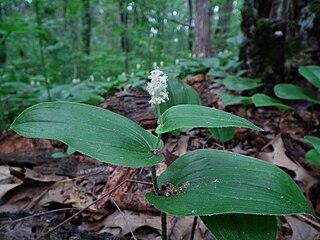
Maianthemum canadense is an understory perennial flowering plant, native to Canada and the northeastern United States, from Yukon and British Columbia east to Newfoundland, into St. Pierre and Miquelon. It can be found growing in both coniferous and deciduous forests. The plant appears in two forms, either as a single leaf rising from the ground with no fruiting structures or as a flowering/fruiting stem with 2-3 leaves. Flowering shoots have clusters of 12–25 starry-shaped, white flowers held above the leaves.

Ranunculus bulbosus, commonly known as bulbous buttercup or St. Anthony's turnip, is a perennial flowering plant in the buttercup family Ranunculaceae. It has bright yellow flowers, and deeply divided, three-lobed long-petioled basal leaves.
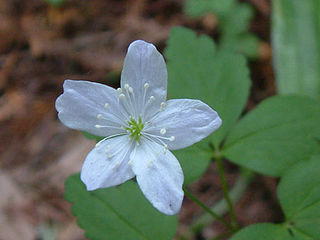
Anemonoides quinquefolia, a flowering plant in the buttercup family Ranunculaceae, is native to North America. It is commonly called wood anemone or windflower, not to be confused with Anemonoides nemorosa, a closely related European species also known by these common names. The specific epithet quinquefolia means "five-leaved", which is a misnomer since each leaf has just three leaflets. A plant typically has a single, small white flower with 5 sepals.

Anemone virginiana is an upright growing herbaceous species of flowering plant buttercup family Ranunculaceae. It is a perennial that grows 30–80 centimetres (12–31 in) tall, flowering from May until July, the flowers are white or greenish-white. After flowering the fruits are produced in a dense rounded thimble shaped spikes 15–35 millimetres (0.59–1.38 in) long and 12 millimetres (0.47 in) wide. When the fruits, called achenes, are ripe they have gray-white colored, densely woolly styles, that allow them to blow away in the wind. The leaf structure is whorled halfway up the stem and each individual leaf appears to be deeply cut. Native from eastern North America, where it is found growing in dry or open woods. This plant can be found in 38 out of the 50 states in the U.S. and is located anywhere from Maine to Minnesota going west, and found as far south as Georgia and Louisiana.
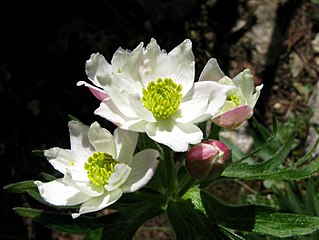
Anemonastrum narcissiflorum, the narcissus anemone or narcissus-flowered anemone, is a herbaceous perennial in the genus Anemonastrum and the buttercup family. Basionym: Anemone narcissiflora Hook. & Arn.

Enemion occidentale is a species of flowering plant in the buttercup family known by the common name western false rue anemone. It is found in California and rarely in Oregon where it is a resident of forest, woodland, and chaparral habitats in many of the mountain ranges. This is a small perennial herb producing one or more erect, unbranched stems growing to maximum heights near 25 centimeters. Leaves appear toward the top of the smooth, naked stems. Each green cloverlike leaf is divided into usually three irregular lobes. The solitary flowers are petite with white to very light lavender petallike sepals and no petals. At the center are white stamens with yellow anthers and white styles with yellow stigmas.

Caltha leptosepala, the white marsh marigold, twinflowered marsh marigold, or broadleaved marsh marigold, is a perennial species of flowering plant in the buttercup family. It is native to western North America from Alaska to New Mexico, where it grows in wet mountain habitats in alpine and subalpine regions. There are two general wild types of this species, one native to the interior and one that grows along the Pacific coast and coastal mountains, but these are not always treated separately.

Kumlienia hystricula is a species of flowering plant in the buttercup family known by the common name waterfall false buttercup.

Anemonoides oregana is a species of flowering plant in the buttercup family known by the common names blue windflower, Oregon anemone, and western wood anemone. It is native to the forests of Washington, Oregon, and northern California in western North America, generally below 7,000 feet (2,100 m) elevation.
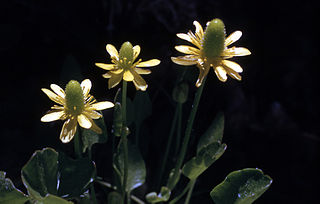
Halerpestes cymbalaria is a species of buttercup known by the common names alkali buttercup and seaside buttercup. It is native to much of Eurasia and parts of North and South America, where it grows in many types of habitat, especially in moist to wet areas such as marshes, bogs, and moist spring meadows. It is a perennial herb producing several stems a few centimeters to nearly 40 centimeters long. Some are prostrate against the ground and are stolons which root in moist substrate, and some are erect. The leaves are variable in shape, the basal ones with notched or slightly divided leaf blades borne on long petioles, and any upper leaves much reduced in size. The inflorescence bears one or more flowers on erect stalks. The flower has five to eight pale yellow petals, each under a centimeter long. The protruding receptacle at the center of the flower becomes a cylindrical cluster of fruits, each of which is an achene.

Ranunculus eschscholtzii is a species of buttercup flower known by the common name Eschscholtz's buttercup.

Ranunculus parviflorus is a species of buttercup known by the common name smallflower buttercup. It is native to Europe, but it is known on other areas of the world as an introduced species and sometimes a roadside weed, for example, in parts of Australia and the United States.

Ribes viscosissimum, also known as sticky currant, is a species of eudicot in the family Grossulariaceae. The species is native to North America. Pacific Northwest, Columbia Plateau, Great Plains, Great Basin, and southwest regions of western North America are native to this plant.
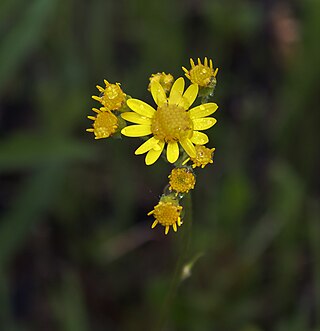
Packera pseudaurea is a species of flowering plant in the aster family known by the common name falsegold groundsel. It is native to North America, where it can be found in western and central parts of Canada and the United States. It grows in mountain habitat such as meadows, streambanks, and woodlands.

Trautvetteria is a genus of flowering plants in the buttercup family. Today it is often considered a monotypic genus, containing only one species, Trautvetteria caroliniensis, which is known by the common names Carolina bugbane, false bugbane, and tassel-rue. A second species, T. japonica, is now generally considered a variety of this species. The genus is named for the botanist Ernst Rudolf von Trautvetter.
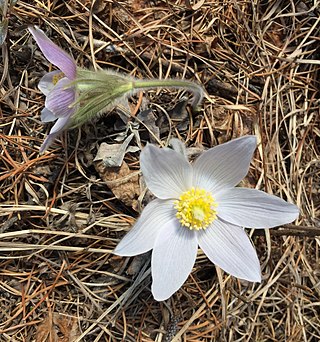
Pulsatilla nuttalliana, known as American pasqueflower, prairie pasqueflower, prairie crocus, or simply pasqueflower, is a flowering plant native to much of North America, from the western side of Lake Michigan, to northern Canada in the Northwest Territories, south to New Mexico in the southwestern United States. Pasqueflower is the provincial flower of Manitoba and the state flower of South Dakota.

Ranunculus pedatifidus is a species of buttercup known by the common names surefoot buttercup, northern buttercup, and birdfoot buttercup. It has a circumpolar distribution, occurring throughout the northern latitudes of the Northern Hemisphere. There are two varieties, var. pedatifidus occurring mostly in Asia and var. affinis mostly native to North America.

Trollius laxus is a rare flowering plant species in the buttercup family, Ranunculaceae. It is native to North America and is considered to have two subspecies, one with a distribution is the east and one in the west. Common names for Trollius laxus include American globeflower and American spreading globeflower. The American Globeflower, Trollius laxus is an endangered species of flowering plants Native to Northeastern United States. This species of plants is limited in range by their ability to exclusively survive in wetlands and marshes. Thus, clusters of the species are constantly threatened by the ever-changing hydrology of the range they are confined to.

Ranunculus arcticus, the birdfoot buttercup, is a species of buttercup in the family Ranunculaceae. It has a circumpolar distribution in Northern Europe, Northern Asia and North America.




















